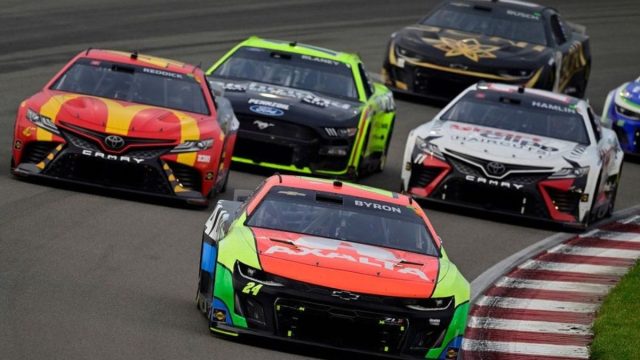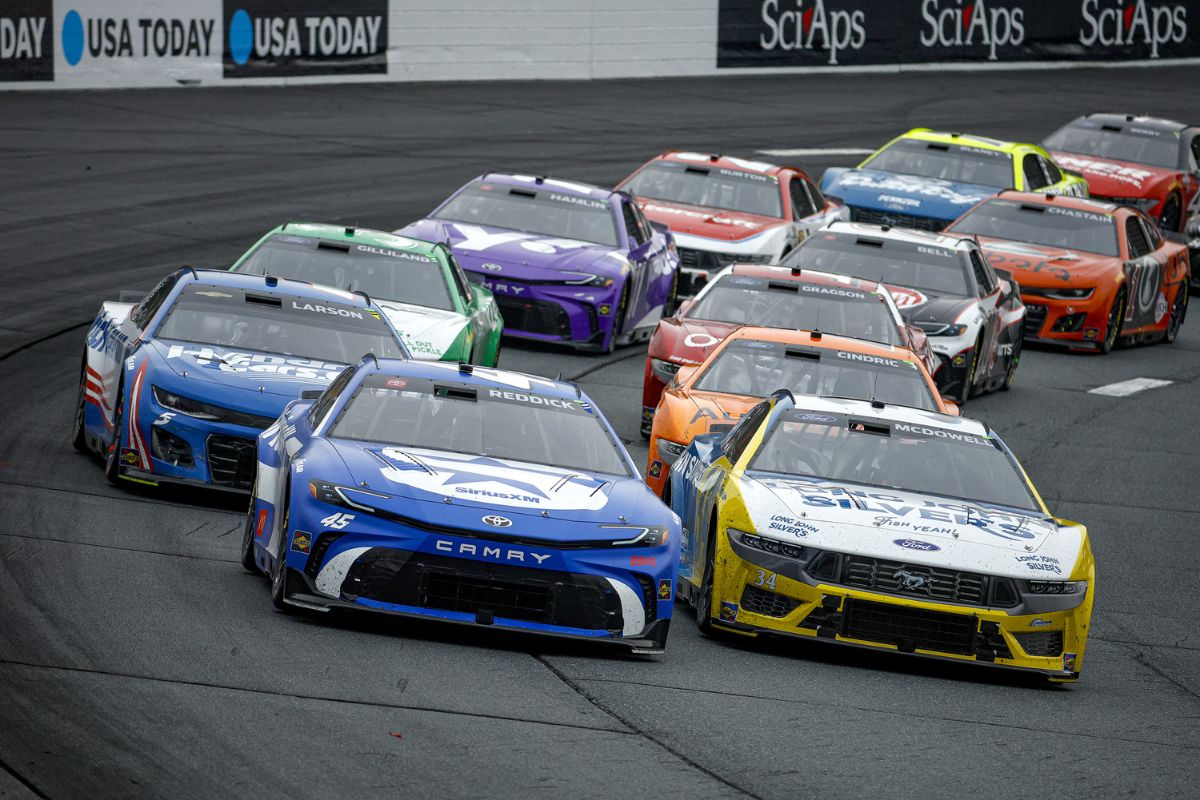NASCAR’s Most Surprising Manufacturer Swaps: The landscape of NASCAR has been significantly shaped by unexpected manufacturer swaps, which redefine team identities and influence competitive strategies. The shift of Richard Petty Motorsports from Dodge to Ford in 2009 exemplifies how deeply rooted affiliations can change, while Joe Gibbs Racing‘s changeover to toyota/”>Toyota in 2008 paved the way for remarkable success. These crucial moves raise questions about the underlying motivations and outcomes associated with such changes. What do these decisions reveal about the future of NASCAR and the constantly changing relationships between teams and manufacturers?
Key Highlights
- Richard Petty Motorsports’ switch from Dodge to Ford in 2009 marked a significant shift in manufacturer loyalty and competitive strategy.
- Joe Gibbs Racing’s transition from General Motors to Toyota in 2008 brought fresh resources and innovation, culminating in a championship win in 2015.
- Team Penske’s move from Dodge to Ford in 2013 emphasized adaptation to new competitive demands and technological advancements.
- Furniture Row Racing’s switch to Toyota in 2016 showed their pursuit of advanced technology and performance enhancement in a competitive landscape.
Importance of Manufacturer Choices in NASCAR
The choice of manufacturer in NASCAR is a crucial decision that can greatly influence a team’s competitiveness, performance, and general success on the track. In a sport where milliseconds can dictate outcomes, the alignment with a particular manufacturer can considerably impact a team’s engineering decisions, financial backing, and overall approach. Over the past two decades, the landscape of manufacturer partnerships has evolved dramatically, creating a dichotomy primarily between Ford and Toyota, while Chevrolet continues to assert its dominance.
The consequences of switching manufacturers are profound. For instance, Richard Petty Motorsports’ shift from Ford to Chevrolet in 2018 exemplifies how such a change can redefine a team’s path. This move was not merely a change in branding; it was a tactical shift that aimed to utilize the engineering skill and resources of Chevrolet, known for delivering competitive performance on the track.
Teams often weigh factors such as technical support, access to advanced technology, and historical performance when choosing their manufacturer. Teams that align with manufacturers offering the latest innovations and consistent performance gains can experience a considerable advantage, while those that lag behind may struggle.
As we look toward the 2024 season, the importance of these manufacturer choices remains crucial, as teams navigate their paths to success in an ever-competitive landscape. Understanding these dynamics is vital for any team aiming to master the intricacies of NASCAR racing.
The Loyalty Between Teams and Manufacturers
Loyalty between teams and manufacturers in NASCAR often resembles a complex partnership, where shared goals and mutual benefits drive a long-term commitment to performance and success. This intricate relationship not only fuels the competitive spirit of the sport but also greatly influences the financial landscape for both entities. Teams often invest decades in collaboration with a manufacturer, refining technologies and tactics to maintain a competitive edge.
The loyalty exhibited in these partnerships is reciprocal. Manufacturers benefit from the success of their teams, as victories translate to increased sales and brand visibility. Conversely, teams thrive on the resources, innovations, and specialized support provided by their manufacturers. However, when performance falters or tactical alignment shifts, teams may reassess their loyalties, seeking opportunities that better serve their aspirations.
Major Manufacturer Changes in NASCAR
Changes in manufacturer loyalty within NASCAR often redefine the competitive landscape, as teams seek new partnerships that promise improved support and innovation.
One of the most notable alterations occurred when Joe Gibbs Racing (JGR) made the substantial decision to switch from General Motors to Toyota in 2008. For the initial 16 seasons, JGR thrived with Pontiacs and Chevrolets, securing three championships. However, the allure of Toyota’s resources and commitment to the sport proved irresistible, marking a crucial moment for both the team and the manufacturer.
At the time of JGR’s change, Toyota was still a relatively newcomer in NASCAR, yet they illustrated a robust willingness to invest in the development of their vehicles and support their teams. This calculated partnership soon paid dividends; in 2015, Toyota celebrated its premier Premier Series championship with Kyle Busch at the helm, a demonstration of the effective collaboration between JGR and Toyota.
The impact of such manufacturer changes extends beyond individual teams, as they can influence the overall dynamics of competition within the sport. When top teams switch allegiances, it often sparks a wave effect, prompting other teams to reassess their partnerships and strategies.
Additional Manufacturer Swaps
In recent years, supplementary manufacturer swaps have emerged as vital moments in NASCAR, reshaping team dynamics and competitive strategies across the series. These shifts not only reflect the evolving landscape of automotive partnerships but also emphasize the tactical calculations teams make in pursuit of performance advantages. The changes have notable implications, often influencing sponsorship dynamics and technology sharing among manufacturers.
Key instances of extra manufacturer swaps include:
- Richard Petty Motorsports (RPM): In 2009, RPM made headlines by leaving Dodge for Ford, marking a notable tactical pivot. The merger with Yates Racing solidified a longstanding relationship with Ford dating back to the 1960s, showcasing the importance of historical ties in these decisions.
- Team Penske: Following RPM’s lead, Team Penske announced their shift from Dodge to Ford in 2013. This move coincided with new model releases from manufacturers and highlighted the need for teams to adapt to competitive demands and changing vehicle specifications.
- Furniture Row Racing: This team made a remarkable switch to Toyota in 2016, which allowed them to utilize Toyota’s advanced technology and support, ultimately aiding their performance on the track.
- Leavine Family Racing: In 2019, they changed from Chevrolet to Toyota, a move that showcased the competitive advantages that can come from aligning with a manufacturer that offers superior resources and engineering support.
Discussion on the Best NASCAR Manufacturers
The competitive landscape of NASCAR is heavily influenced by the performance and strategies of its leading manufacturers: Chevrolet, Ford, and Toyota, each vying for supremacy on the track.
As of 2023, Chevrolet stands out as the dominant force, boasting an impressive 851 race wins and 42 manufacturer championships. This remarkable record emphasizes Chevrolet’s long-standing commitment to performance and innovation, making them a formidable contender in the ongoing quest for the Cup series title.
Ford, with its rich history in NASCAR, continues to be an important player. While it has a legacy filled with iconic moments and competitive vehicles, it currently trails Chevrolet in total wins and championships. The challenge for Ford lies in evolving its strategies and engineering to reclaim its former glory in a landscape increasingly defined by advanced technology and aerodynamic precision.
Toyota, the newest entrant among the trio, has made notable strides since its debut in NASCAR. Although it has yet to surpass Chevrolet in terms of sheer victories, Toyota’s rapid development and consistent performance indicate that it is a manufacturer that cannot be overlooked. Their investment in talent and technology has allowed them to carve out a respectable niche, often challenging the traditional leaders.
As the season unfolds, the question remains: can Chevrolet maintain its dominance, or will Ford and Toyota rise to the occasion? The competition promises to be fierce, with each manufacturer bringing unique strengths and strategies to the racetrack.

News in Brief: NASCAR’s Most Surprising Manufacturer Swaps
The landscape of NASCAR has been profoundly shaped by calculated manufacturer swaps, revealing the complex relationship between teams and their automotive partners.
Such shifts not only reflect the changing priorities within the sport but also highlight the critical role that manufacturer allegiance plays in a team’s competitive edge.
As the dynamics of the racing environment continue to evolve, the adaptability of teams in aligning with the right manufacturers will remain crucial in determining future successes and challenges.
ALSO READ: NASCAR Playoffs Schedule Chaos: Insider Slams Controversial Track Changes


